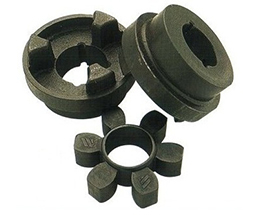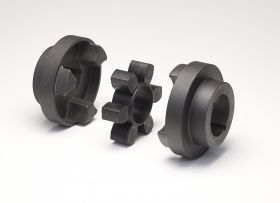Product Description
NM Coupling, NM Rubber Coupling Elements, NM Rubber Spider
| Material: | NBR, CSM/SBR | Color: | Black |
| Tensile Strength: | 12Mpa | Hardness: | 80shore A |
| Elongation: | 350% | Density: | 1.25g/cm3 |
| Size: | NM50, NM67, NM82, NM97, NM112, NM128, NM148, NM168, NM194, NM214, NM240, NM265 |
NM coupling
NM type is precisely produced by a special designed synthetic rubber with 2 similar bodies of cast iron
Cast iron flanges:
Designed not only for the power transmission but also for protection of flexible rubber
Flexible rubber:Applications for pumps, fans, compressors, vehicles, transporting equipments, constructors, cement mixers, tractors, transmission machines, metal working machines, rollers and all other transmissions
Made of rubber and steel cores are inserted in the teeth so as to provide excellent durability and performance of coupling
Features:
Economical and practical using
Quiet and smooth operation
Easy installation and maintenance
Available to machines with high torque and intermittent operation
Characteristics of the synthetic rubber: proper elasticity and resistance to damping, oil, acids and alkalie
Specifications:
1: with CE certificate
2: full detection of quality before delivery
3: OEM is welcomed
4: rich experience in precision casting
material: CSM/SBR, NBR
color: black.
surface: smooth
tensile strength: 12Mpa
hardness: 80Shore A
elongation: 400%
density: 1.25g/cm3
elasticity impact: >25%
tear strength: 35KN/m
working temperature: 100oC
standard size:
NM50, NM67, NM82, NM97, NM112, NM128, NM148, NM168, NM194, NM214, NM240, NM265
Physical character: made by injection with high quality polyester or mould CSM/SBR. It is designing and special for all kinds of metal shaft coupling with very good performance of high tensile strength, high wear resistant, high elastic resilience, water resistant, oil resistant and excellent fatigue resilience, high impact resistant etc. We have full sets moulds and supply full range of GR, GS, MT, Hb, HRC, L, NM and Gear J series couplings with high quality and excellent experience. Apply to all kinds of industrial metal shaft coupling.
Specifications:
material: polyester, CSM/SBR
color: yellow, red, purple, green, black etc.
surface: smooth
tensile strength: 12-55Mpa
hardness: 80-98Shore A
elongation: 400%-650%
density: 1.25g/cm3
elasticity impact: >25%
tear strength: 35-155KN/m
CHINAMFG abrasion loss: <0.05cm3/1.61km
compression set (22h*70oC): <10%
working temperature: 120oC
standard size for polyurethane coupling:
GR14, GR19, GR24, GR28, GR38, GR42, GR48, GR55, GR65, GR75, GR90, GR100, GR110, GR125, GR140, GR160, GR180
MT1, MT2, MT3, MT4, MT5, MT6, MT7, MT8, MT9, MT10, MT11, MT12, MT13
HRC70, HRC90, HRC110, HRC130, HRC150, HRC180, HRC230, HRC280
L35, L50, L70, L75, L90/95, L99/100, L110, L150, L190, L225, L276
FALK-R 10R, 20R, 30R, 40R, 50R, 60R, 70R, 80R
standard size for rubber coupling:
Hb80, Hb95, Hb110, Hb125, Hb140, Hb160, Hb180, Hb200, Hb240, Hb280, Hb315
HRC70, HRC90, HRC110, HRC130, HRC150, HRC180, HRC230, HRC280
L35, L50, L70, L75, L90/95, L99/100, L110, L150, L190, L225
NM50, NM67, NM82, NM97, NM112, NM128, NM148, NM168, NM194, NM214, NM240, NM265
Gear 3J, 4J, 5J, 6J, 7J, 8J, 9J, 10J, 11J
special size build molding according to the buyer’s drawings
***when you enquiry, pls confirm product’s number and quantity***
/* January 22, 2571 19:08:37 */!function(){function s(e,r){var a,o={};try{e&&e.split(“,”).forEach(function(e,t){e&&(a=e.match(/(.*?):(.*)$/))&&1
| Standard: | DIN, ANSI, GB |
|---|---|
| Material: | Nr+SBR |
| Connection: | Flange |
| Surface Treatment: | Nothing |
| Head Type: | Round |
| Type: | Nm Type |
| Samples: |
US$ 10/Piece
1 Piece(Min.Order) | |
|---|
| Customization: |
Available
| Customized Request |
|---|


Can HRC Couplings Handle Misalignment Between Shafts?
HRC (Highly Resilient Coupling) couplings are designed to handle a certain degree of misalignment between shafts, making them suitable for applications where alignment issues may arise. These couplings can accommodate both angular and parallel misalignment to some extent, providing flexibility and resilience in mechanical systems.
The flexibility of HRC couplings is primarily due to their construction, which typically includes a flexible element made of rubber or other elastomeric materials. This flexible element sits between two metal hubs and absorbs misalignment by allowing a certain degree of movement.
There are generally two types of HRC couplings based on their ability to handle misalignment:
- Single Flex HRC Couplings: These couplings can accommodate angular misalignment but have limited capability to handle parallel misalignment. They are suitable for applications where angular misalignment is more prevalent.
- Double Flex HRC Couplings: These couplings are designed to handle both angular and parallel misalignment to a greater degree than single flex couplings. They offer increased flexibility and can handle more demanding misalignment conditions.
It is important to note that while HRC couplings can handle misalignment, they do have limits. Excessive misalignment beyond their specified range can lead to premature wear and failure. It is essential to follow the manufacturer’s guidelines and ensure that the coupling is properly installed and aligned to prevent unnecessary stress on the flexible element.
For applications with significant misalignment or where precise alignment is critical, other types of couplings like flexible couplings with elastomeric elements, gear couplings, or disc couplings may be more suitable. Engineers and designers should carefully assess the misalignment requirements of their specific application and choose the appropriate coupling type accordingly.

What Role Does an HRC Coupling Play in Reducing Downtime and Maintenance Costs?
An HRC (Highly Resilient Coupling) plays a significant role in reducing downtime and maintenance costs in mechanical systems. Here’s how:
1. Vibration Damping: HRC couplings are designed with a flexible rubber element that acts as a vibration damper. The rubber element absorbs and dampens vibrations generated during the operation of rotating machinery. By reducing vibrations, the coupling helps prevent excessive wear and fatigue on connected equipment, such as motors, pumps, and gearboxes. This leads to less frequent breakdowns and extends the lifespan of components, ultimately reducing downtime for repairs and replacements.
2. Misalignment Compensation: As mentioned earlier, HRC couplings can handle various types of misalignment, including angular, parallel, and axial misalignment. By accommodating these misalignments, the coupling helps prevent additional stress on the connected shafts and bearings. The ability to handle misalignment reduces the likelihood of premature failures and breakdowns caused by misalignment-related issues.
3. Shock Load Absorption: In many industrial applications, rotating machinery may experience sudden shock loads due to various factors like sudden starts, stops, or changes in load. The flexible rubber element in the HRC coupling acts as a shock absorber, cushioning the impact of these sudden loads. By absorbing shock loads, the coupling protects the connected equipment from damage and minimizes the risk of unexpected downtime due to shock-related failures.
4. Easy Installation and Maintenance: HRC couplings are relatively easy to install and maintain. They do not require complex alignment procedures, and the flexible element eliminates the need for lubrication. The simple design and ease of maintenance contribute to reducing the time required for installation and upkeep, thus lowering overall maintenance costs.
5. Cost-Effective Design: HRC couplings are cost-effective compared to some other types of couplings. They provide reliable performance and durability at a reasonable price point. The cost-effectiveness of HRC couplings makes them a popular choice in various industrial applications where reducing operational costs is a priority.
Overall, the HRC coupling’s ability to dampen vibrations, compensate for misalignment, absorb shock loads, and offer easy installation and maintenance translates into improved reliability and efficiency of mechanical systems. This, in turn, leads to reduced downtime and maintenance costs, making HRC couplings a valuable component in power transmission applications across industries.

Advantages of Using HRC Couplings in Mechanical Systems
1. Flexibility: HRC couplings offer flexibility in accommodating misalignment between shafts, both angular and parallel. This flexibility helps to reduce stress on the connected equipment and increases the overall reliability of the system.
2. Vibration Damping: The elastomeric spider in HRC couplings acts as a cushion, absorbing vibrations and shock loads, which results in smoother and quieter operation of the machinery.
3. Simple Design: HRC couplings have a straightforward design, consisting of just two hubs and an elastomeric spider. This simplicity makes them easy to install, assemble, and maintain.
4. Cost-Effective: Compared to some other types of couplings, HRC couplings are cost-effective, providing reliable performance at a relatively lower cost.
5. High Torque Transmission: HRC couplings can handle high torque transmission, making them suitable for various heavy-duty applications.
6. Misalignment Compensation: They can compensate for small amounts of misalignment between shafts, which can occur due to factors like thermal expansion or shaft deflection.
7. Corrosion Resistance: The elastomeric spider in HRC couplings provides some level of corrosion resistance, making them suitable for applications in harsh environments.
8. Wide Range of Sizes and Torque Ratings: HRC couplings are available in various sizes and torque ratings, making it easy to find a suitable coupling for different power transmission requirements.
9. Electrically Insulating: Some HRC couplings are electrically insulating, which can be advantageous in certain applications to prevent electrical currents from passing between connected shafts.
10. Reduced Downtime: Due to their ability to absorb shock loads and vibrations, HRC couplings can help reduce wear and tear on machinery, leading to less downtime and lower maintenance costs.
Overall, HRC couplings are a reliable and widely used choice for connecting shafts in mechanical systems, providing flexibility, vibration dampening, and cost-effectiveness in a wide range of applications.


editor by CX 2024-04-25
by
Tags:
Leave a Reply